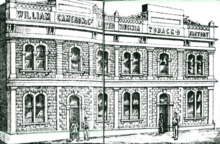|
L. P. LawrenceLaurie Phillip Lawrence (1 March 1838[1] – 14 August 1923) was a businessman and philanthropist in South Australia. HistoryLawrence was born in Dover, England, and was educated at Wanstall's academy, Chatham, Kent. At the age of 15[1] he left for Australia and the Victorian gold diggings, but had little success.[2] He worked as clerk and storeman on a sheep station near Bathurst and at a softgoods warehouse in Melbourne, where in 1862 he married, before moving to New Zealand, where the Otago gold rush was under way. If he went prospecting success once again eluded him, but he stayed in Dunedin for three years.[1] Somehow that did not work out, and he returned to Australia. Back in Melbourne, he found employment as a travelling salesman for I. Jacobs & Co., wholesale tobacconists. In 1875 he was appointed manager of their Brisbane office,[3] which was at the time an offshoot of their Sydney branch. He either found that arrangement unsatisfactory, or the climate,[4] and was given management of their Adelaide office, which traded as Feldheim, Jacobs & Co. The company became Jacobs, Hart, & Co. (Adelaide) in 1883, and Lawrence became a partner in the Adelaide firm. In 1888 the Melbourne partnership of Isaac Jacobs (c. 1835–1914) and Alfred David Hart (c. 1849–1928) was dissolved, and Jacobs withdrew from the Adelaide firm, which became Hart, Lawrence & Co.,[5] whose establishment included Wm. Cameron & Company's Virginia Tobacco Factory, Grenfell Street, near Hindmarsh Square; Wm. Cameron & Co. being an American company, the factory having been established by Feldheim, Jacobs, & Co. in 1876.[6] His son Philip M. Lawrence was manager of the factory.  In 1890 Lawrence and son Philip settled a strike by tobacco workers and in 1896 Hart and Lawrence restructured the business as Hart, Lawrence, & Co. Pty, Ltd, with Lawrence as Managing Director.[7] and later still as the States Tobacco Company. In 1900, with the certain prospect of Federation and the abolition of inter-state duties, there was no longer any advantage to companies having separate factories in each State, and the three Adelaide tobacco factories (Wm. Cameron & Co., H. R. Dixson, and Dungey, Ralph & Co.) sought to cut costs by reducing the men's wages. The unions called a strike, whereupon the owners closed the South Australian factories,[8] and Hart & Lawrence became solely a wholesale outlet for the Victorian manufacturers. Lawrence retired as a director of States Tobacco in 1904, having been for 20 years closely associated with the mercantile life of South Australia. He was
He was active in a range of philanthropic movements: he was
On the social and sporting side he was
He was highly respected as a gentleman and citizen, and mourned by a wide circle of friends.[2] FamilyLawrence married Frances "Fanny" Anderson (c. 1835 – 27 January 1894) on 23 September 1862.[13] they had four sons and two daughters:—
They had a home, "Chatham" on Melbourne Street (first from Brougham Place, facing south).[15] Connection, if any, to Lawrence's Tobacco Store, corner King William and Rundle streets, has not yet been established. References
|